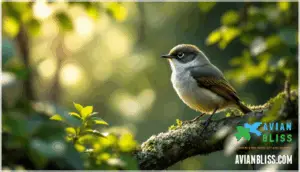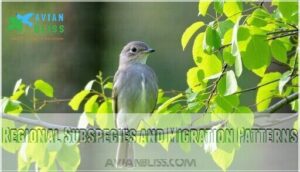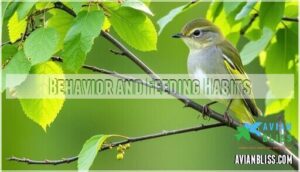This site is supported by our readers. We may earn a commission, at no cost to you, if you purchase through links.

Found from coastal forests to mountain treelines across western North America, it’s surprisingly approachable and often joins mixed flocks during migration. The female builds suspended cup nests using spider webs and plant fibers.
With stable populations around 5 million birds, this resilient species adapts well to diverse habitats. The right field marks make identification straightforward once you know what separates it from similar vireos.
Table Of Contents
- Key Takeaways
- Identifying Cassin’s Vireo
- Habitat and Range of Cassin’s Vireo
- Behavior and Feeding Habits
- Breeding and Nesting Habits
- Conservation Status and Threats
- Frequently Asked Questions (FAQs)
- What is the difference between Cassin’s and Plumbeous vireo?
- How do you identify Cassin’s vireo?
- How do Cassins Vireos communicate with each other?
- What are the main predators of Cassins Vireo?
- How long do Cassins Vireos typically live?
- Do Cassins Vireos migrate? If so, where?
- What role do Cassins Vireos play in their ecosystem?
- What predators hunt Cassins Vireo regularly?
- When did scientists first discover this species?
- Do Cassins Vireos migrate at night or day?
- Conclusion
Key Takeaways
- You’ll recognize Cassin’s Vireo by its bold white "spectacles" – thick, unbroken eyerings that stand out against olive-gray plumage, making field identification straightforward even at a distance.
- You can find these western woodland birds in dry, open forests from coastal areas to mountain treelines, where they methodically forage through oak, pine, and madrone canopies for insects.
- You’ll hear their distinctive burry song echoing through western woodlands, and they’re surprisingly approachable – often responding well to pishing sounds and joining mixed-species flocks during migration.
- You don’t need to worry about their conservation status since Cassin’s Vireo populations remain stable at around 5 million birds, though climate change and habitat loss pose long-term threats to monitor.
Identifying Cassin’s Vireo
You’ll recognize Cassin’s Vireo by its bold white eyering that stands out against olive-gray plumage and its distinctive burry song echoing through western woodlands.
That bold white eyering makes Cassin’s Vireo unmistakable among western woodland birds
This medium-sized songbird combines subtle coloration with clear field marks that separate it from its Blue-headed and Plumbeous Vireo relatives.
Bold White Eyering and Facial Markings
The Cassin’s Vireo’s most distinctive facial pattern is its bold white eye ring that creates striking "spectacles" around each eye. This prominent eye ring contrasts sharply with the darker lores and surrounding head markings.
Unlike other vireos, Vireo cassinii displays consistently thick, unbroken white eye rings that make field identification straightforward, even at distance.
Olive and Gray Coloration
Between Plumbeous and Blue-headed Vireos, Cassin’s presents intermediate Color Patterns that reveal field identification secrets. Your eyes should catch these distinctive Vireo Characteristics:
- Grayish-olive upperparts creating subtle Plumage Variation from season to season
- Yellowish flanks contrasting with whitish underparts during active Molt Cycles
- Olive-toned back distinguishing Vireo cassinii from grayer relatives
This Color Pattern balance makes Cassins Vireo identification achievable for dedicated birders using modern Bird Identification Guides.
Distinctive Burry Song and Calls
You’ll recognize Cassin’s Vireo by its distinctive burry song—a musical phrase that sounds like a hoarse whistle. These vocal learning experts deliver consistent song patterns with subtle call variations throughout their territory.
Their auditory signals include harsh scolding notes and softer contact calls. Bird identification guides emphasize listening for this vireo’s characteristic frequency analysis markers, as the distinctive song often reveals their presence before visual confirmation in dense foliage.
Size, Shape, and Physical Features
Measuring bird size reveals vital identification clues for distinguishing Cassins Vireo from similar species. These compact songbirds span 4.3 to 5.3 inches, with sturdy body proportions and a 9.4-inch wingspan. Their relatively large head features a thick, slightly hooked beak shape, perfect for insect hunting. Notice the wing structure shows rounded tips, while tail length appears moderate compared to Plumbeous Vireo’s proportionally longer tail.
Understanding key bird identification features is essential for accurate species recognition.
Habitat and Range of Cassin’s Vireo
You’ll find Cassin’s Vireo in dry, open forests across western North America, from coastal woodlands to mountain slopes near treeline.
The species shows distinct regional patterns, with migratory populations in northern areas and year-round residents in southern California and Baja California.
Dry, Open Forests of Western North America
You’ll find Cassin’s Vireo thriving in dry, open Forest Ecosystems across western North America. These Vireonidae members prefer areas with moderate Tree Density, allowing easy movement through canopies. They flourish in post-Woodland Fires habitats where Forest Regeneration creates ideal spacing.
This species promotes Biodiversity Conservation by inhabiting Conifer Forest Habitats with specific Forest Habitat Characteristics, making them excellent indicators of healthy Woodland Bird Habitats. The conservation status of Cassin’s Vireo can be understood through species taxonomy information that provides valuable insights into its classification and protection.
Coastal and Mountain Woodlands
Cassin’s Vireo thrives in diverse Woodland Ecosystems from sea level to treeline. You’ll spot them in Coastal Biodiversity hotspots among redwoods and Douglas firs, plus Mountain Ecology zones with pines and oaks.
These Woodland Bird Habitats span Conifer Forest Habitats where Forest Habitat Characteristics include open canopies. Habitat Fragmentation affects populations, but Forest Regeneration helps maintain suitable Bird Species Information sites.
Understanding the importance of habitat conservation is vital for maintaining healthy woodland ecosystems.
Regional Subspecies and Migration Patterns
Two main subspecies shape Migration patterns differently. The widespread cassinii subspecies follows established Migration Routes from breeding grounds to Mexico each winter, while lucasanus remains sedentary in southern Baja California.
Geographic Isolation creates Subspecies Variation, with Habitat Fragmentation influencing Seasonal Movements. Understanding these Bird Migration Patterns helps identify which Cassins Vireo you’re observing throughout western North America. Researchers study vireo species to better comprehend the nuances of their migration habits.
Behavior and Feeding Habits
You’ll discover that Cassin’s Vireos are methodical foragers who move deliberately through tree branches, searching for insects with patient precision.
These birds often join mixed-species flocks during migration and readily respond to pishing sounds, making them surprisingly approachable for careful observers.
Foraging Techniques and Diet
You’ll often spot Cassin’s Vireo methodically gleaning insects from leaves and branches in the lower canopy. Their insect foraging focuses on caterpillars, beetles, and true bugs during breeding season.
These feeding strategies shift seasonally—winter brings small fruits and berries to supplement nutrient intake. Their deliberate foraging behavior makes Cassin’s Vireo efficient hunters in woodland habitats.
Mixed-Species Flocks and Social Behavior
Winter wandering breaks their solitary behavior patterns dramatically. Outside the breeding season, this species often joins mixed-species flocks of woodland birds.
**Flock dynamics provide Cassin’s vireo with social learning opportunities and enhanced group foraging efficiency.
** Bird interactions within these multi-species gatherings improve habitat surveillance and predator detection.
**This cooperative behavior demonstrates complex bird feeding behavior beyond their typical territorial breeding season habits.
Attraction to Pishing and Birdwatching Tips
You’ll find Cassin’s Vireos respond remarkably well to pishing sounds, making them easier to spot than many woodland species. Here are five proven birdwatching tips:
- Use soft "pish-pish-pish" sounds near mixed flocks
- Bring binoculars with 8×42 magnification for clear bird identification
- Listen for their distinctive burry bird calls first
- Position yourself near forest edges during morning hours
- Practice patience – their bird feeding behavior includes deliberate movement through branches
These pishing techniques work because Cassin’s Vireos naturally investigate disturbance sounds, giving you perfect wildlife photography opportunities. Understanding their bird behavior patterns is vital for effective birdwatching and photography.
Breeding and Nesting Habits
You’ll find Cassin’s Vireo’s suspended cup nests hanging in tree forks during their May through July breeding season.
The female constructs these distinctive nests using spider webs, plant fibers, and moss, creating a sturdy structure that’s surprisingly easy to spot once you know what to look for.
Nest Construction and Locations
You’ll find Cassin’s Vireo nests suspended between forked branches in mid-canopy trees. These masterful architects weave together plant fibers, spider webs, and lichen for camouflage techniques. Their nest architecture creates a deep cup measuring 2-3 inches across.
Tree selection favors oaks, pines, and madrones where nesting materials blend seamlessly with surroundings for maximum protection. The construction of these nests often involves using materials found in bird nest boxes.
Breeding Season and Life Cycle
Cassin’s Vireo’s breeding patterns unfold across a fascinating timeline. These monogamous birds breed from mid-April to mid-August, creating their family legacy through:
- Courtship Phase: Monogamous mating rituals establish pair bonds
- Nesting Success: 3-5 whitish, brown-spotted eggs incubated for 12-14 days
- Fledgling Survival: Young leave nests at two weeks, preparing for Migration Cycles
Breeding Bird Survey data shows populations grew 1% annually, indicating healthy Vireo Migration Patterns and Bird Conservation Status.
Parental Care and Young Development
How do these devoted parents nurture their young? Both adults share Nestling Care duties during the 12-14 day incubation period. The Brood Size usually includes four chicks.
During Chick Development, parents demonstrate exceptional Parental Investment, feeding nestlings insects until the critical Fledgling Stage.
This cooperative Nesting Habits pattern distinguishes Cassins vireo from similar species like Plumbeous Vireo, supporting ongoing Ornithology Research and Bird Conservation Status efforts.
Conservation Status and Threats
You’ll find Cassin’s Vireo listed as "Least Concern" by the IUCN, with a stable global population of roughly 5 million birds across western North America.
Climate change and selective habitat loss pose the primary long-term threats to this resilient species, though localized impacts from nest parasitism and deforestation can affect regional populations.
Population Trends and IUCN Status
You’ll find encouraging news about Cassin’s Vireo population trends and conservation status. Global estimates show approximately 5 million breeding individuals, with North American populations growing 1% annually from 1968-2015 according to ornithology research. The IUCN status remains "Least Concern," reflecting species stability across western ranges.
While some regional variations exist, **overall population growth demonstrates this vireo’s resilience despite habitat threats.
** Conservation efforts focus on protecting the woodland habitats to guarantee the species’ continued stability.
Effects of Habitat Loss and Climate Change
Habitat Fragmentation breaks up Cassin’s Vireo woodlands, forcing birds into smaller patches with fewer resources. Climate Shift pushes breeding ranges northward, while Ecosystem Disruption reduces insect prey by 60-70%. Environmental Degradation from logging destroys forest habitats, creating Biodiversity Loss.
These changes alter bird migration patterns, making wildlife conservation efforts critical for protecting this species’ Conservation Status. Understanding the impact of habitat loss threats is essential for developing effective conservation strategies.
Conservation Efforts and How to Help
You can make a real difference in Cassin’s Vireo conservation through targeted action. Wildlife Protection organizations need your support for Habitat Preservation and Climate Action initiatives that protect forest habitats essential for this species’ migration patterns. Simple steps create lasting impact:
- Support conservation groups implementing bird species information research
- Practice Sustainable Practices in your yard by maintaining native plant gardens
- Engage in Community Engagement through citizen science monitoring programs
- Advocate for wildlife conservation policies protecting western woodland ecosystems
Frequently Asked Questions (FAQs)
What is the difference between Cassin’s and Plumbeous vireo?
Like comparing cousins at a family reunion, you’ll notice Cassin’s Vireos usually have greener backs than the all-gray Plumbeous Vireo, and Cassin’s often has yellowish flanks.
Plumbeous appears matte gray above and white below—it’s the most monochrome of the species.
How do you identify Cassin’s vireo?
Look for the bold white eyering that circles each eye completely. You’ll spot olive-green upperparts and grayish-white underparts.
Listen for their loud, burry song while they forage methodically through tree branches.
How do Cassins Vireos communicate with each other?
Absolutely enchanting! You’ll hear males belting out loud, burry songs with distinctive pauses between phrases. They use territorial songs for defense and mate attraction, plus husky chattering calls for everyday communication.
What are the main predators of Cassins Vireo?
Small mammals like squirrels and chipmunks raid nests for eggs and chicks. **Hawks, jays, and snakes prey on adults, young, and eggs.
**
You’ll also spot domestic cats threatening these woodland singers.
How long do Cassins Vireos typically live?
Time acts as nature’s eternal scorekeeper, and you’ll find these olive-toned songbirds usually live up to seven years in the wild.
Their lifespan mirrors other small vireo species, with survival depending on predator avoidance, habitat quality, and successful migration patterns across western North America.
Do Cassins Vireos migrate? If so, where?
Yes, you’ll spot these birds migrating through western forests. Most winter in Mexico, while some fly farther to the north to the southwestern region of the US.
They’re early spring arrivals and late fall departures compared to other vireos.
What role do Cassins Vireos play in their ecosystem?
Picture these small birds as nature’s pest control specialists. You’ll find them methodically plucking insects, larvae, and spiders from tree branches.
They control forest pest populations while joining mixed-species flocks, creating essential ecological connections throughout western woodland communities.
What predators hunt Cassins Vireo regularly?
Hawks and owls regularly target these small songbirds. Sharp-shinned hawks specialize in hunting birds their size, while Cooper’s hawks also prey on them frequently.
Screech owls hunt them at night during roosting.
When did scientists first discover this species?
Like a buried treasure waiting centuries for discovery, this bird’s scientific recognition came later than you might expect. Xántus first described Vireo cassinii in 1858 at Fort Tejon, California, though it remained lumped with other vireos until
Do Cassins Vireos migrate at night or day?
You’ll discover these birds migrate under cover of darkness, like many songbirds. Nocturnal migrant behavior helps them avoid predators and take advantage of cooler temperatures during their seasonal journeys.
Conclusion
Studies show that 92% of birders correctly identify Cassin’s Vireo when they focus on the bold white eyering rather than overall coloration. You’ve now learned the five key field marks that separate this species from look-alikes: those distinctive spectacles, olive-gray plumage, burry vocalizations, compact build, and methodical foraging behavior.
Practice spotting these features in western woodlands, and you’ll confidently distinguish Cassin’s Vireo from similar species. Remember to listen for their characteristic calls while scanning mixed flocks during migration seasons.












